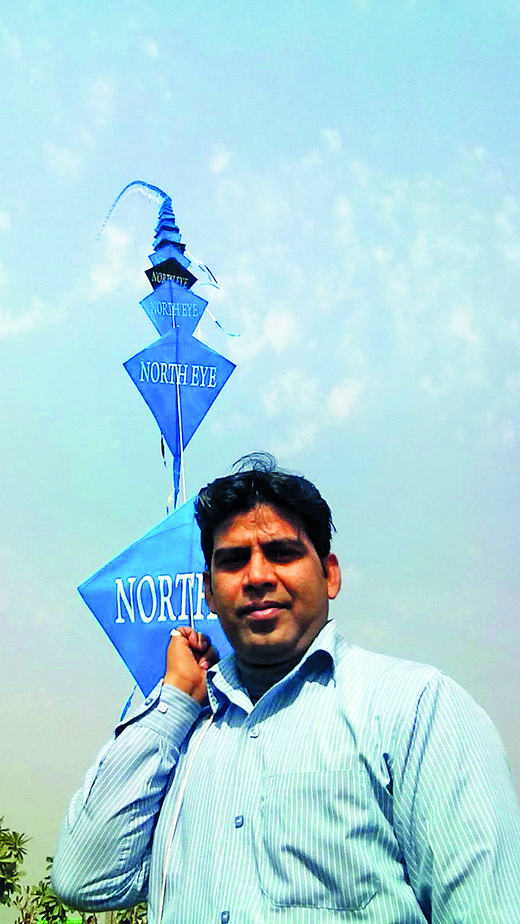
Jamaluddin carries forward his father's legacy
When he was a child, he used to watch intently while his father flew kites. For Syed Mohiuddin alias Bhai Mian, kite flying was not a profession but a passion. Sure enough, Bhai Mian came to be dubbed the “godfather” of patangbaazi. Among the city’s many kite clubs, ‘Diamond Kite Club’, one of Delhi’s oldest, was started by him in 1970. He holds a record of flying 1,187 kites on a single string.
Carrying forward the late patangbaaz’s legacy for the last two decades, his elder son Jamaluddin recalls, kite flying is in his blood. “Every evening, my father’s friends gathered at our place. Together they used to fly kites. I used to stand next to my father and watch the intriguing sight of colourful kites flying high in the open sky,” he recalls. This, of course, was in a mohalla (neighbourhood) of Delhi-6, Matia Mahal. The Jama Masjid and the whole Chandini Chowk area is visible from his terrace.
It was also from his father that he learnt the precision, the detailing and the perfection that is required to make kites. And now, his kites are in huge demand. Many companies and organisations approach Jamal for promotional purposes. “We use kites as a marketing tool by carrying out advertisements for brands, companies or events. Like we have done for Lays, Delhi Daredevils and Commonwealth Games,” he says. Apart from that, demonstration of kites is done during special occasions like Independence Day, Makar Sakranti, Lohri and others, claims Jamal.
But what is of utmost importance is how kite flying as a sport has been flourishing due to the efforts of people like Jamal. He took part in many kite flying festivals, both in India and abroad. “I’ve attended kite festivals in Dubai, Switzerland, Maldives, Bangladesh and other parts of the world as well,” he says. He informs that the kite festivals of today are much different from those of the earlier days. “Nowadays it’s more of a demonstration of kites. Earlier, competitions were held in these events,” recalls Jamal. “Recently I was called in to the ‘Island Tourism Festival’ at Andaman and Nicobar Islands to conduct a workshop in kite flying and kite making. It was a wonderful experience altogether,” states an ecstatic Jamal.
Indian kites are called ‘fighter kites’, claims Jamal. “Owing to their light weight, they have high mobility, which helps a kite flyer tame their kites without hindrance during a game,” he adds. This explains the name given to it. But, he also draws attention to the shortcomings of Indian kites. “In India, kites are made of paper or plastic, which make them fragile. But abroad, they make kites using cloth, which are quite sturdy and long lasting,” he explains. But that hasn’t stopped him from acquiring immense recognition and success.
Irrespective of the rich history of patangbaazi in Delhi, it is often considered a dying sport. Jamal holds the same view. The reason, according to him, is the lack of interest amongst young people. “Young kids are always engrossed in their mobile phones. They hardly step out of their homes these days, let alone participate actively in any sport,” a disappointed Jamal claims. Another dampener he mentions is lack of availability of open spaces.
“Kite flying should be given the same status as any other sport in the country,” he firmly recommends. “In recent times, kabaddi came into limelight. Kite flying should also be publicised and brought into the forefront”, he adds. But what could be done to implement such a change? “The government should support the sport. Only then will a change in scenario take place,” he suggests.
He strongly recommends that the government set up institutions or training centres which would teach kite flying. “There should be separate training grounds, which would be dedicated solely for the purpose of kite flying. And, it is a sport, which like any other, requires proper teaching and training. For that, setting up of institutions is necessary,” Jamal elaborates.
He dreams of a day when patangbaazi, like other sports, will be given its much deserved position and status. “There should be live screening of kite flying, just like cricket, kabaddi, football. Then only it will reach a wider audience, awaken interest among the youngsters and will be given its due respect and place in the society,” says a hopeful Jamal. He further adds that kite flying is a great exercise for the body, as well as the mind. This fact is often overlooked or not taken into consideration. Thus, kite flying is more than just a pastime or hobby. It is a game of balance which requires healthy eyesight and immense concentration.
Jamaluddin, in his long career, has achieved a lot. But what still holds a special place in his heart is how hundreds and hundreds gather to watch their kite flying demonstration during Delhi haat festival. “It really motivates us, gives us moral support to continue our work,” he says. But when asked what he thinks is in store for the future of kite flying, a humble Jamal says, “Ek alag modh, ek alag shakal miley patangbaazi ko, yehi chahiye” (Kite flying should get a new direction, a new face in the society, that’s all I want). Till then, the struggle to restore the lost glory of patangbaazi will remain.
A scientific committee has been constituted, which has already held meetings to recommend effective pollution-control…
He said NIA has the supervening power of taking over all the investigation, particularly in…
Delhi saw 14 murders in 15 days, with police expressing concern over the involvement of…
Vehicles without a valid PUC certificate will not be allowed to refuel at petrol pumps…
Six passengers from Bangkok were arrested at IGI Airport after customs seized over 48 kg…
Delhi Police arrest three men, a woman and a juvenile in Mukherjee Nagar stabbing; woman…